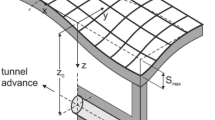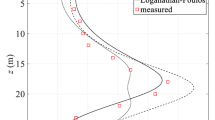Abstract
Tunneling-induced ground movements are investigated in this paper using both deterministic and probabilistic analyses. The deterministic model is based on three-dimensional (3D) numerical simulations using the commercial code FLAC3D. This model attempts to reproduce some major phenomena during a typical slurry-shield tunnel excavation (ground movements due to the applied face pressure, the overcutting, the shield conicity, the annular void behind the shield, and the grout injection in this void). Moreover, the model provides useful information about the nature and magnitude of the soil movements at the ground surface. A probabilistic study is then undertaken in order to evaluate the impact of the variability of several input variables on the ground movements. An efficient probabilistic method called CSRSM is used to assess this uncertainty propagation. In a last section, the output variables of the model are linked to failure criteria. This allows one to determine probabilities of failure, depending on the probabilistic properties of the input variables and on the admissible threshold of each criterion.











Similar content being viewed by others
References
AFTES (1983) La méthode convergence confinement, recommandations, Tunnels et Ouvrages Souterrains, no 59., 32 p
Ahmed M, Iskander M (2011) Analysis of tunnelling-induced ground movements using transparent soil models. J Geotech Geoenviron Eng 137(5):525–535
Augarde CE, Lyamin AV, Sloan SW (2003) Stability of an undrained plane strain heading revisited. Comput Geotech 30:419–430
Benmebarek S, Kastner R, Ollier C (1998) Auscultation et modélisation numérique du processus de creusement à l’aide d’un tunnelier. Geotechnique 48(6):801–818
Bernat S, Cambou B (1998) Soil-structure interaction in Shield Tunnelling in Soft Soil. Comput Geotech 22(3):221–242
Burd HJ, Houlsby GT, Augarde CE, Liu G (2000) Modelling tunnelling-induced settlements of masonry buildings. Proc Inst Civ Eng Geotech 143:17–29
Dias D, Kastner R, Maghazi M (1999) Three dimensional simulation of slurry shield tunneling. International Symposium on Geotechnical Aspects of Underground Construction in Soft Ground, Tokyo, Japan, 6p
Houmadi Y, Ahmed A, Soubra AH (2012) Probabilistic analysis of a one-dimensional soil consolidation problem. Georisk: Assess Manag Risk Eng Syst Geohazards 6(1):36–49
Huang SP, Liang B, Phoon KK (2009) Geotechnical probabilistic analysis by collocation-based stochastic response surface method: an Excel add-in implementation. Georisk: Assessment and Management of Risk for Engineered Systems and Geohazards 3(2):75–86
Isukapalli SS (1999) An uncertainty analysis of transport-transformation models, Ph.D. thesis, The State University of New Jersey, New Brunswick, New Jersey
Jenck O, Dias D (2004) Analyse tridimensionnelle en différences finies de l’interaction entre une structure en béton et le creusement d’un tunnel à faible profondeur. Geotechnique 8(54):519–528
Kasper T, Meschke G (2006) On the influence of face pressure, grouting pressure, and TBM design in soft ground tunnelling. Tunn Undergr Space Technol 21:160–171
Kielbessa S, Duddeck H (1991) Stress-strain fields at the tunneling face. Three dimensional analysis for two dimensional technical approach. Rock Mech Rock Eng 24:1203–1209
Klar A, Osman AS, Bolton M (2007) 2D and 3D upper bound solutions for tunnel excavation using ‘elastic’ flow fields. Int J Numer Anal Methods Geomech 31(12):1367–1374
Leca E, Dormieux L (1991) Upper and lower bound solutions for the face stability of shallow circular tunnels in frictional material. Géotechnique 40(4):581–606
Li D, Chen Y, Lu W, Zhou C (2011) Stochastic response surface method for reliability analysis of rock slopes involving correlated non-normal variables. Comput Geotech 38–1:58–68
Mao N, Al-Bittar T, Soubra AH (2012) Probabilistic analysis and design of strip foundations resting on rocks obeying Hoek-Brown failure criterion. Int J Rock Mech Min Sci 49(1):45–58
Maynar MJM, Rodriguez LEM (2005) Discrete numerical model for analysis of earth pressure balance tunnel excavation. J Geotech Geoenviron Eng 131(10):1234–1242
Migliazza M, Chiorboli M, Giani GP (2009) Comparison of analytical method, 3D finite element model with experimental subsidence measurements resulting from the extension of the Milan underground. Comput Geotech 36:113–124
Mollon G, Dias D, Soubra A-H (2009) Probabilistic analysis and design of circular tunnels against face stability. Int J Geomech ASCE 9(6):237–249
Mollon G, Dias D, Soubra A-H (2009) Probabilistic analysis of circular tunnels in homogeneous soils using response surface methodology. J Geotech Geoenv Eng ASCE 135(9):1314–1325
Mollon G, Dias D, Soubra A-H (2010) Face stability analysis of circular tunnels driven by a pressurized shield. J Geotech Geoenv Eng ASCE 136(1):215–229
Mollon G, Dias D, Soubra A-H (2011) Rotational failure mechanisms for the face stability analysis of tunnels driven by a pressurized shield. Int J Numer Anal Meth Geomech. doi:10.1002/nag.962
Mollon G, Dias D, Soubra A-H (2011) Probabilistic analysis of pressurized tunnels against face stability using collocation-based stochastic response surface method. J Geotech Geoenv Eng ASCE 137(4):385–397
Mollon G, Dias D, Soubra A-H (2011) Extension of CSRSM for the parametric study of the face stability of a pressurized tunnel. Risk Assessment and Management in Geoengineering (Georisk 2011), Atlanta, USA, 26-28 June 2011, http://www.univ-nantes.fr/soubra-ah, 8p
Mroueh H (1998) Tunnels en site urbain : Modélisation numérique et interaction creusement-ouvrages existants, PhD Thesis, Ecole Centrale de Lille, 132p (in French)
Mroueh H, Shahrour I (2008) A simplified 3D model for tunnel construction using tunnel boring machines. Tunn Undergr Space Technol 23:38–45
Phoon KK, Huang SP (2007) Geotechnical probabilistic analysis using collocation-based stochastic response surface method. In: Kanda, Takada and Furada (eds) Applications of statistics and probability in civil engineering. Taylor and Francis Group, London
Phoon K–K, Kulhawy FH (1999) Evaluation of geotechnical property variability. Can Geotech J 36:625–639
Potts DM, Addenbrooke TL (1996) The influence of an existing surface structure on the ground movements due to tunnelling. In: Proceedings of the international conference on geotechnical aspects of underground construction in soft grounds. Balkema, Rotterdam, The Netherlands, pp 573–578
Soubra AH, Mao N (2012) Probabilistic analysis of obliquely loaded strip foundations. Soils Found 52(3):524–538
Sudret B (2007) Global sensitivity analysis using polynomial chaos expansion. Reliab Eng Syst Saf 93:964–979
Vermeer PA, Ruse N, Marcher T (2002) Tunnel heading stability in drained ground. Felbau 20(6):8–18
Xiu D, Karniadakis GE (2002) The Wiener-Askey polynomial chaos for stochastic differential equations. J Sci Comput 24(2):619–644
Author information
Authors and Affiliations
Corresponding author
Rights and permissions
About this article
Cite this article
Mollon, G., Dias, D. & Soubra, AH. Probabilistic analyses of tunneling-induced ground movements. Acta Geotech. 8, 181–199 (2013). https://doi.org/10.1007/s11440-012-0182-7
Received:
Accepted:
Published:
Issue Date:
DOI: https://doi.org/10.1007/s11440-012-0182-7




